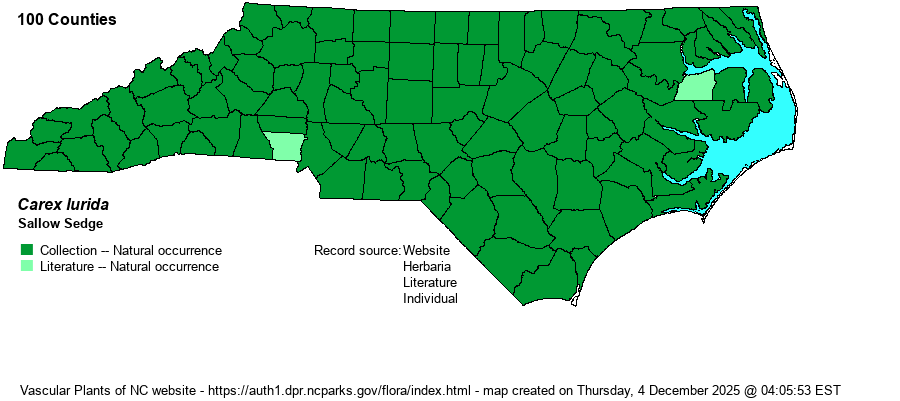| Author | Wahlenberg | |
| Distribution | Throughout the state, but curiously absent from the Outer Banks and barrier islands.
N.S. to MN south to FL, TX, and Mex. | |
| Abundance | One of our most common sedges -- common to very common throughout. | |
| Habitat | A wide variety of wet habitats, from swamps, floodplains, and marshes to roadside ditches and powerlines. |
| Phenology | Flowering and fruiting April-August. | |
| Identification | Knowing this species well helps greatly when identifying other "look-alikes" with "corncob" female spikes. In general the spikes are yellowish or pale green as compared with its relatives and look-alikes. Ignore plants with immature achenes (seeds), as they may not key properly. There is huge variation in size of female spikes; i.e., in number of perigynia per spike, from half a dozen to more than 50. | |
| Taxonomic Comments | None
The genus Carex is the largest in North America, and among the largest in the world. In temperate and boreal regions, Carex is often the dominant or co-dominant ground layer in many habitats. Seeds (achenes) are valuable food for birds and small mammals, while foliage is used by birds and mammals to make nests and as food by mammals. Species of Carex often look vastly different from one another -- spikes erect vs. drooping, tiny inflorescence vs. whopping, culms leafy vs. naked, perigynia beaked vs. beakless, stems densely bunched vs. single, etc. The genus has been divided into many sections (or groups), based on shared characters; some taxonomists have suggested that these be different genera, but that proves unworkable (so far). All Carex share the feature of a perigynium (an outer covering) which completely surrounds the achene (seed). This covering may fit tightly or loosely (like a small bladder), depending on which group or species. Details of perigynia shape, ornamentation, presence and size of beak, number of striations (or veins) are all important ID features. In recent years Rob Naczi and colleagues have stressed the importance of arrangement of perigynia -- whether spiral (3+ ranks) or distichous (2-ranked) -- and have named a number of new species as well as split off some older synonyms. Therefore, RAB's (1968) key, excellent for its time, can only be used in a general way today. Members of some sections of Carex are difficult to key out (notably Ovales, Laxiflorae, Griseae); this is in part due to variation among individuals of a species, or failings of the key. FNA has drawings of most species and some species may be found in two or more places within a key, to acount for variability. New species to NC, and new to science(!), continue to be found in NC. | |
| Other Common Name(s) | Incorrectly named as Shallow Sedge by many websites and references. "Sallow" means "of an unhealthy yellow or pale brown color", presumably referring to the female spikes. Also named as Lurid Sedge. | |
| State Rank | S5 | |
| Global Rank | G5 | |
| State Status | | |
| US Status | | |
| USACE-agcp | OBL link |
| USACE-emp | OBL link |

